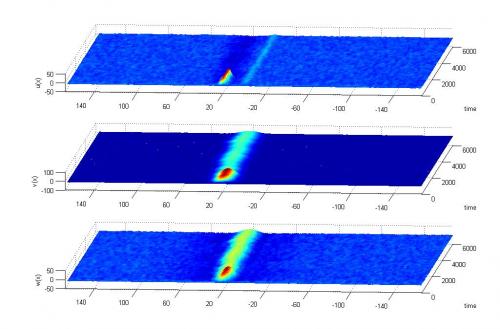Click here to view a video about the Spatial Memory and Cognition Lab
Dynamic Field Theory of Spatial Memory

The Dynamic Field Theory of spatial memory is a dynamic systems model of spatial memory that uses dynamic neural fields. Dynamic neural fields are based on the population dynamics of neurons in cortex. The activation of neurons in the field evolves over time. Changes in activation patterns depend on interaction between neurons in the field as well as inputs to the field.A memory for a location is modeled as a peak of activation in a field. Due to neuronal interaction, the peak self-sustains. What happens to the peak during the memory delay and how that varies over development is the focus of most of our work.
The influence of attention on spatial memory
Many studies have shown that spatial attention plays a role in spatial memory in adults (e.g., Awh & Jonides). The role of attention in spatial memory in young children, however, has not been examined in detail, even though children with Attention Deficity/Hyperactivity Disorder display deficits in spatial working memory in addition to attention deficits. This connection between attention deficits and spatial memory is not well understood due to a lack of research on how attention influences spatial memory in early development. This line of research uses different approaches, including spatial memory tasks and parental report, to examine how attention influences spatial memory in 3- to 6-year-olds through adults.
Rest activities and cognition
The purpose of this line of research is to examine how various rest and relaxation activities can promote cognitive processing in children.  One area of this research is examining how spending time in a natural environment improves executive function in children. Previous research indicates that for children diagnosed with Attention Deficit Hyperactivity Disorder, a 20 minute walk in a park enhanced attention in subsequent tasks (Taylor & Kuo, 2009). Taylor & Kuo (2009) also reported that a walk in the park was significantly more beneficial than a walk in an urban area or a walk in a residential area. This research examines in more detail whether time in natural areas has unique restorative properties for attention and other cognitive abilities using both behavioral measures and EEG.
One area of this research is examining how spending time in a natural environment improves executive function in children. Previous research indicates that for children diagnosed with Attention Deficit Hyperactivity Disorder, a 20 minute walk in a park enhanced attention in subsequent tasks (Taylor & Kuo, 2009). Taylor & Kuo (2009) also reported that a walk in the park was significantly more beneficial than a walk in an urban area or a walk in a residential area. This research examines in more detail whether time in natural areas has unique restorative properties for attention and other cognitive abilities using both behavioral measures and EEG.
Spatial Recall vs. Recognition Memory
When children and adults remember a location in a homogeneous space, their memories tend to be biased away from the boundaries of a region and toward the center of the space. This bias in memory has been called a categorical bias, because memory responses are biased toward the center of spatial categories (e.g., the left half of a monitor). Different theories have explained this in different ways. One question that has been debated recently is whether we retain an unbiased memory of the specific location which is then biased at recall by the blending of categorical and specific memory information. Previous research suggests that categorical and coordinate (or specific) memories are separate until recall at which time the two different sources of information are blended together. This issue has implications for how memory operates and what the neural mechanisms may be. Results of previous research, however, have been mixed. This line of research examines factors that may influence categorical bias in recognition memory and examines the development of these biases in both recognition and recall memory tasks.